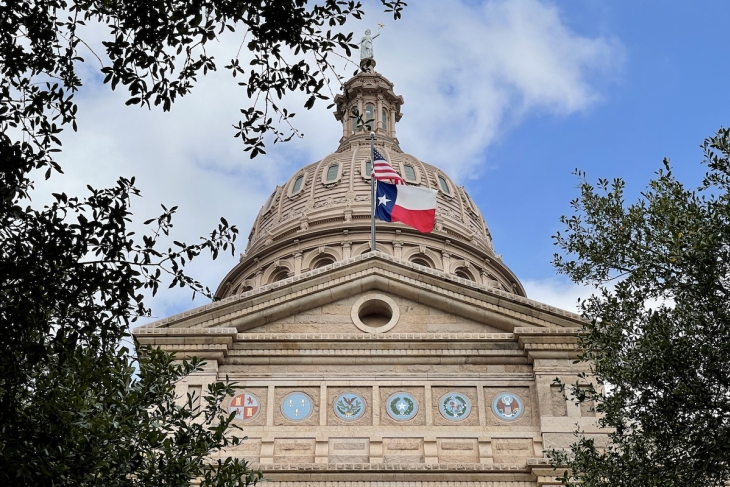Texas legislators returned to Austin earlier this week to try once again to enact a statewide school-choice program in the form of education savings accounts. Post-pandemic, Governor Greg Abbott is one of several state executives who have enthusiastically embraced the popular policy innovation known as “ESAs.” However, it remains to be seen whether legislators will agree to make the Lone Star State the fourteenth to enact such a program. That’s because the issue of school choice in Texas divides lawmakers not only along partisan lines, but rural-urban ones, as well—to say nothing of recent internecine feuds that would give D.C. a run for its money. But regardless of how the knotty politics play out for ESAs, Texas is quickly re-emerging as the most interesting state in the union when it comes to education reform.
Indeed, the pursuit of “education freedom” is just one of several noteworthy initiatives underway. As I wrote last month, the state’s takeover of Houston’s giant Independent School District could blaze new ground in how to turn around large, dysfunctional urban school systems. Test results will ultimately help gauge whether the effort is deemed successful, but early indicators appear promising. Districtwide, student misbehavior is down significantly from the previous year—especially in the eighty-five schools implementing Mike Miles’s wholesale transformation model. Teacher absences have also dropped precipitously, declining nearly 40 percent. While the national issue of chronic absenteeism has largely been focused on students, less talked about is the problematic increase in teachers calling out sick.
Texas school boards and educators are watching. Up until last month, Austin ISD also faced the prospect of a state takeover. Shortcomings in providing special education services had for years plagued the district in Texas’s capital city, putting it firmly in the Texas Education Agency’s crosshairs. To avoid an all-out takeover, Austin’s board of trustees voted to accept the state’s “alternative plan,” which requires additional monitoring of special education.
Close observers may note the parallels with how Houston eventually ended up in hot water. HISD’s elected trustees could have avoided a full-on state conservatorship if they had surrendered control of one of the district’s lowest-performing schools. Instead, they called what they thought was the state’s bluff. It proved to be a grave error, and thus taught local officials in Austin to heed TEA’s resolve. A lesson learned is that, in Texas, you can hang your hat on the state stepping in if school districts don’t deliver on their obligation to students. (There have been fifteen previous state takeovers in Texas over the last three decades.) That’s something which can’t be said convincingly of most other states.
At the same time, Texas is in the process of “refreshing” the formula for its A–F accountability system. Not unlike other states that employ similar school ratings, Lone Star schools and districts evaluated with letter grades feel pressure to improve, which in the aggregate leads to higher achievement and test scores. Through the years, however, Texas has been watering down its standards and giving in to demands for less rigorous measures. For example, between 2019 and last year (Texas adopted the A–F system in 2017), the number of schools in Houston ISD receiving A or B ratings rose from 135 to 213—this despite the pandemic. During the same period, the number of D or F schools declined from forty-seven to seventeen. Now, Texas is preparing to raise the bar, which in the short term will increase the number of failing schools. To wit, when the new ratings are released later this month, Houston anticipates that up to eighty schools will fall within the D or F category.
Proving that no good deed goes unpunished, more than a dozen districts have sued the state in response to rising standards. (Texas has over 1,000 school districts.) A key point of contention is the CCMR—College, Career, and Military Readiness—portion of the rating system. Previously, a high school would get an A if just 60 percent of its seniors either enrolled in college, pursued a career, or joined the military. The updated criteria lift that benchmark to 88 percent. There are other arguments from these districts, too, but ultimately, their protests reflect a larger aversion to having hard (and honest) conversations with parents about student performance, as well as being generally allergic to accountability. It’s worth noting that in Florida, where A–F ratings were birthed, the state revised its formula nine times over eighteen years. With other states lowering the bar or even hiding the ball, it’s refreshing to see Texas’s commitment to raising expectations.
What’s more, the state is no slouch when it comes to academic rigor and racial equity, especially as it relates to advanced mathematics. A new Texas law signed by Abbott in May calls for middle school students in the state to be automatically enrolled in advanced math if they score in the top 40 percent of the state’s exam. The new practice will likely increase the number of students ready to enroll in algebra in the eighth grade, especially Black and Latino students who have historically been shut out of advanced math courses. In Dallas ISD, the policy has increased the share of Black sixth graders from 17 percent enrolled in honors math to 43 percent; the percentage of Latino sixth graders from one-third to nearly 60 percent. In high school, this should translate to more Black and Latino students in calculus and statistics. Again, Texas is raising the bar.
Texas has also gone against the grain in its strategic provision of tutoring for struggling students. While other states hemmed and hawed about the utility of state test results during Covid, lawmakers in Texas embraced the use of assessment data and enshrined specific tutoring requirements for students performing below grade level. Specifically, a law signed by Abbott in June 2021 required schools to provide at least thirty hours of tutoring to each student that did not pass the state exam. To be sure, implementation proved to be logistically challenging, but directionally, the spirit of data-powered education recovery is one worth emulating.
Overseeing this renaissance is the state’s highly capable and admirably wonky education commissioner, Mike Morath. One of the longest-serving state chiefs in the country, Morath is also one of the most interesting. Unlike the firebrands among some in the Texas political class, he has carved a unique niche in the nation’s second largest state for K–12 enrollment by focusing on policy and data, not politics and dogma. Like his hand-picked superintendent in Houston, Morath has little interest in today’s culture war fights and is motivated instead by the mission of empowering families and doing right by Texas’s students. A father of four himself, he has spoken passionately about his struggles with finding the right school for each of his children and how the experience fueled his dedication to arming parents with more and better information.
Back in the early aughts, part of what brought then Governor George Bush to the presidency (and ushered in NCLB) was pretty solid evidence that Texas’s school reforms up to that point had done a lot of good—especially for the state’s most marginalized children. Along with North Carolina, Rand was rating Texas as being at the top. Bush capitalized on this success and wanted to apply it to the entire country. I remember working as a teacher in the Rio Grande Valley at that time and thinking to myself that there was something special happening with regard to focusing energy and attention on poor and minority students—including the emerging use of test results to do well by them.
Today, many of Texas’s important efforts continue to rely on the data provided by state standardized testing—using it to help drive resources and target interventions. So while assessment and accountability continue to shrink in the nation’s rearview mirror, the opposite is true in the Lone Star State, where everything seems to be getting bigger when it comes to school reform.


